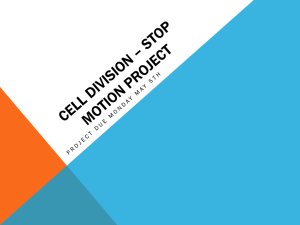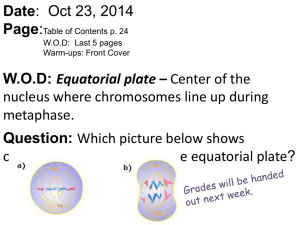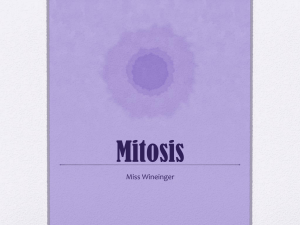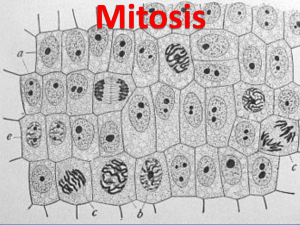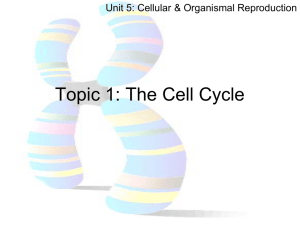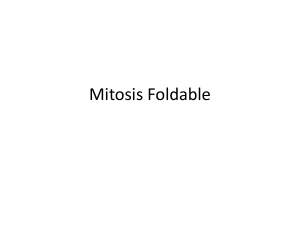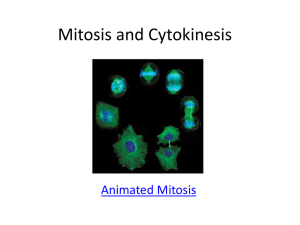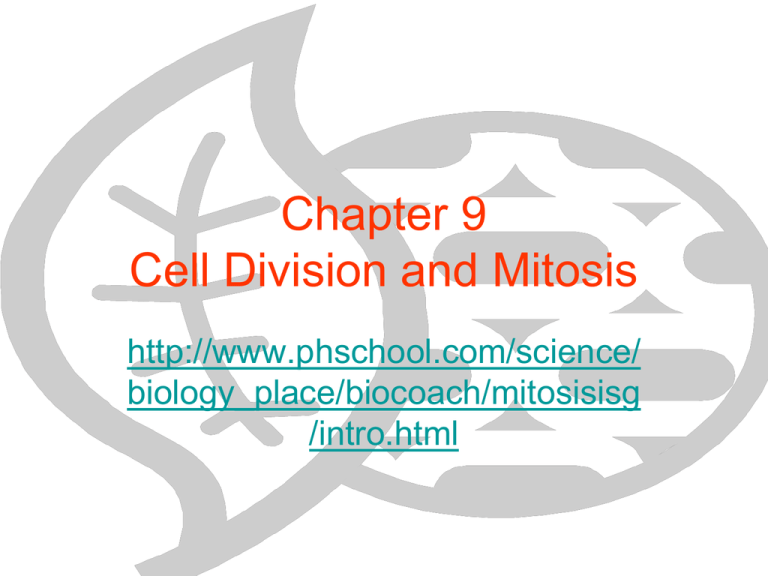
Chapter 9
Cell Division and Mitosis
http://www.phschool.com/science/
biology_place/biocoach/mitosisisg
/intro.html
Why do Cells divide?
• Growth
• Reproduction (for single cell organisms)
• Repair
Cycle of Life
• The cycle of life includes fertilization of
gametes, cell division, and growth,
production of gametes, and death.
• All of life depends of life
Overview of Division mechanisms
• Before a cells are able to reproduce, there
must be a division of nucleus and its DNA
• Mitosis: used by multicellular organisms
for growth by repeated division of somatic
(body cells)
– This division helps cells grow, replace dead,
or worn-out cells and repair tissues
• Meiosis: only occurs in germ cells that
divide to form gametes (sex cells)
Chromosomes
• Each chromosomes is a molecule of DNA
complexed with proteins
• Human DNA is 2 meters long
– Prior to cell division, each threadlike
chromosomes is duplicated to form two sister
chromatids held together by a centromere
– The centromere is also the region where the
duplicated chromosome will attach to the
microtubules of the spindle during nuclear
division
Continue
• Proteins called histones tightly bind to
DNA and cause spooling into a structural
unit called nucleosome
Mitosis and Chromosome Number
• Each organisms has a definite
chromosome number
– Example: Humans have 46 chromosomes
• Chromosomes exists in pairs (one from
each parent)
– Humans have 23 pairs of chromosomes
– Somatic Cells are diploid (pairs)
– Germ cells (sperm and egg cells) are haploid
(half the number of total chromosomes)
Cell Cycle
• A recurring sequence of events that
extends from the time of a cell’s formation
until each division is complete
– Three phases of cell cycle: Interphase,
Mitosis , and Cytokinesis
Interphase
• Is the portion of the cell cycle is which the
cell prepares for cell division (nuclear and
cytoplasmic)
• Three phases of Interphase
– G1 phase: Carbohydrates, lipids, and proteins
for cell’s own use and for export assembled
– S phase: DNA is copied and proteins are
synthesized used in organizing the condensed
chromosomes
– G2 phase: the proteins that will drive mitosis to
completion are produced
Mitosis Overview
• Nuclear Division that occurs in four
phases: Prophase, Metaphase, Anaphase,
and Telophase (PMAT)
• Spindle apparatus (fibers) moves toward
chromosomes
– Composed of two sets of microtubules
– Extend from two poles of cell and overlap at
the cell’s equator
Prophase
• Chromosomes become visible as rodlike
units, each consisting of two sister
chromatids
• Nuclear envelope begins to break down
• Spindle apparatus move toward the poles
Prometaphase
• Nuclear envelope fragments
• Spindle apparatus attach to the
centromere
Metaphase (M&Ms)
• Longest Stage of Mitosis
• Nuclear membrane breaks up completely
in the transition between pro- and
metaphase
• Chromosome aligns at the cell’s equator,
halfway between the poles—also known
as the metaphase plate
Anaphase
• Sister chromatids separate and move
toward opposite poles
• Spindle apparatus shorten and pull the
chromosomes toward the poles
• Once separated each chromatid is now an
independent chromosomes
Telophase
• Two daughter chromosomes of each
original chromatid pair at opposite pair
• Chromosome return to the threadlike form
typical of chromosome
• Each daughter cell has the same number
of chromosomes as the parent cell
Cytokinesis
• Division of cytoplasm
• Plants
– Because of rigid cell wall, the cytoplasm of
plant cells can not simply pinch off, the plant
cell forms a cell plant to separate the two
nucleus
– Made from vesicles derived from the Golgi
apparatus
Continue…
• The flexible plasma membrane of animal
cells can be squeezed in the middle to
separate the two daughter cells
– First sign of cleavage is the appearance of a
cleavage furrow, a shallow groove in the cell
surface near the old metaphase plate
Mitosis is amazing!!!
• Mitosis is accomplished with astonishing
accuracy
• There are times when mistakes happen
(too many chromosomes or chromosomes
deleted).
– This is known as a mutation (genetic
mistakes)
Binary Fission
• Prokaryotes cell division
• 1- Bacterium have circular chromosomes
replicate and move apart
• 2- the point chromosome replication is
known as origin of replication
• 3- Each origin of replication will move
opposite end of the cell
Continue…
• 4- Cell elongates
• 5- Cytoplasm begins to pinch in
• 6- divides
Cell Cycle Control
• Cell cycle control system: a cyclically
operating set of molecules in the cell that
both triggers and coordinates key events
in the cell cycle
– Checkpoint: in the cell cycle is a critical
control point where stop and go-ahead signals
can regulate the cycle
– Animal cells generally have built in stop
signals to halt the cell cycle
– 3 major checkpoints: G1, G2, M phases
Regulatory Proteins
• 1- Kinases: drives the cell cycle
– Present at constant concentration throughout
the entire cell cycle throughout the entire cell
cycle
• 2- Cyclin: attaches to kinases
– Cyclically fluctuating in the cell cycle
– At checkpoint times is when you see the
fluctuating
– This helps the cell have the correct number of
chromosomes
Growth Factor
• A protein released by certain cells that
stimulates other cells to grow
Density-dependent inhibition
• Phenomenon in which crowded cells stop
growing
Loss of cells cycle in cancer cells
• Cancer cells do not respond to the body’s
control mechanisms
– Transformation the process that converts a
normal cell to a cancer cell
• Immune system recognize a transformed cells
and destroys it
• However, if the cell evades destruction it may
proliferate and form a tumor (a mass of
abnormal cells within otherwise normal tissue)
Two types of tumors
• 1- Benign Tumor: abnormal cells remain at
the original site
• 2- Malignant tumor: becomes invasive
enough to impair the functions of one or
more functions (this is when a person
have cancer)
Metastasis
• Spread of cancer cells to locations distant
from their original site
– This is usually done through the blood vessels
and lymph vessels

